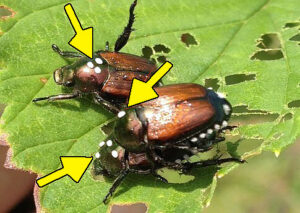
Winsome fly eggs are found on three Japanese beetles, including a mating pair (with a female Japanese beetle shown below the male). One or more eggs are laid on each beetle; eggs are nearly always laid just behind the head. The Winsome fly prefers to lay eggs on female Japanese beetles. / Photo Credit: Jacques Lasnier, Quebec, Bugwood.org
By Bill Hutchison, Department of Entomology
University of Minnesota
Hutch002@umn.edu
The Winsome fly (Istocheta aldrichi (Mesnil)), part of the Tachinidae family, is a parasitoid of the invasive pest Japanese beetle (Popillia japonica).
A parasitoid is an insect whose larvae develop in or within a host insect of a different species, eventually killing it.
The Winsome fly was introduced in 1923 in New Jersey as a biological control agent of the Japanese beetle, six years after the Japanese beetle was accidentally introduced in the United States. Since then, the Winsome fly has become established in the Northeastern states and Quebec and Ontario in Canada.
It’s also notable that about 20 years after the Winsome fly was introduced in Minnesota, the insect expanded its range from eight counties in 2023 to 22 counties in 2024.
Also, last year, through the efforts of several volunteers and PJ Liesch at the University of Wisconsin-Madison Insect Diagnostic Lab, the Winsome fly has now been documented in 10 counties in Wisconsin. In 2024, the easternmost detections in Wisconsin were near Wausau, in Marathon County; the northernmost detection was in Oneida County.

A close-up photo of a Winsome fly, which in larval form is a parasitoid of the Japanese beetle. / Photo Credit: University of Maine, Bugwood.org
Effective Control Agent
The Winsome fly is considered one of the more effective biological control agents of the Japanese beetle for multiple reasons:
- A good match in life cycle timing (known as phenology) between adult fly emergence and Japanese beetle emergence.
- The direct impact of 20-50% parasitism rates.
- The impact of Winsome fly parasitism in reducing the number of eggs a female Japanese beetle female is able to produce.
- Its ability to adapt to a variety of climatic conditions.
By far, the easiest way to detect activity of the Winsome fly is not the adult fly itself, because adult flies are very difficult to observe and properly identify in the field. Rather, it is best to search for its distinctive white eggs, which are laid just behind the head of the Japanese beetle.
Given the recent detections in Wisconsin, the Winsome fly is anticipated to establish a presence in more counties. Following the phenology of the Japanese beetle, the Winsome fly season was expected to begin during the last week of June and extend through the end of August.
Fly’s Secrets Of Success
During the past three years, several Winsome fly traits have been observed that appear to be contributing to the ongoing success of this parasitoid in the upper Midwest:
- The timing (phenology) of the emergence of the Winsome fly is now aligned well with the phenology of Japanese beetle adult emergence (e.g., from late June to early August, southern Minnesota).
- Effective adult searching ability, as indicated by high egg-lay rates when Japanese beetle host densities are low (e.g., early or late season), and 30-55% parasitism at higher host densities (July).
- Although the parasitized Japanese beetle will die within 5-10 days, it’s important to note that due to the parasite’s larval growth and damage to the host’s internal organs, Japanese beetle stop feeding within 3-4 days and lethargic behavior becomes obvious.
- Due to the end of feeding after 3-4 days, much less foliar damage is caused by parasitized Japanese beetle adults.
- Winsome fly has a significant preference for laying eggs on Japanese beetle females; when females are parasitized, they do not lay their full complement of eggs (normally about 80 eggs per female).
- Due to these factors, Winsome fly can both reduce the current year’s Japanese beetle population (direct mortality), and reduce Japanese beetle egg-laying during summer and fall, resulting in lower Japanese beetle populations the following year.
Observation Reports Requested
The University of Minnesota has issued a request that observers report Winsome fly sightings in Wisconsin. Learn how to sign up as an observer and post observations on the iNaturalist app on the university’s Winsome fly reporting page. For more information on the project, contact Bill Hutchinson of the University of Minnesota Department of Entomology.
Read more about the Winsome fly and its relationship with the Japanese beetle on the University of Minnesota’s online fact sheet page.
